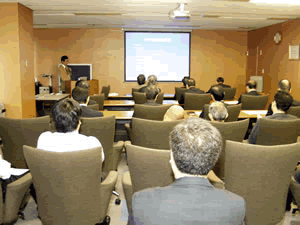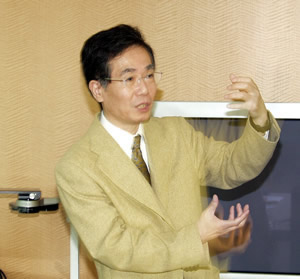|
|
 |
| |
On November 16, 2006, the 89th Safety Caravan was held at the Nuclear Fuel Transport Company Limited (NTF) in Minato ward, Tokyo .
|
| Safety Presentation
|

|
|
During the safety presentation
|
Twenty NTF employees attended the safety presentation.
At the outset of the lecture, NTF President Yoshimitsu Kajii gave an opening speech in which he stated: "If we begin to have a sense of satisfaction that we have reached a considerably high level of safety, the culture of nuclear safety has already started to come undone. These are the words of an English scholar. In a certain sense, I would like to make today an opportunity to wind the 'watch of safety' again, and I hope that everyone will do the same."
After the opening address, an overview of the activities was presented by Mr. Hamada, manager of the Nuclear Safety Network Division. Then, Mr. Shigeo Kojima, Deputy Chief Engineer at Computer Software Development Company Limited, delivered a lecture entitled "Lessons from the Columbia Accident and the Safety Climate of Organizations." |
Lecture highlights |

|
|
Mr. Shigeo Kojima
|
Highlights of the valuable lecture:
○ The results of an analysis of the report investigating why the accident occurred were presented with regard to some of the factors related to the cause of the space shuttle accident including technical issues, organizational issues, financial issues, issues from the standpoint of project management and so on. There were also factors such as a tear in the thermal protection system on the leading edge of the left wing due to foam insulation that broke off, which was a physical cause of the accident; organizational barriers that impeded the communication of safety information and repressed disparities in the opinions of experts, which were organizational causes; plans that were not managed in an cross-sectional and integrated manner: as well as a decision-making process that existed which did not conform to the organization's rules.
○NASA's organizational problems were discussed at length in the accident report as being one cause of the accident. It was explained that the absence of safety culture at NASA became one of the principal factors leading to the accident. Additionally, the lessons of this accident indicate the necessity of 1) understanding the actual state of the organizational and safety cultures and making improvements to them; 2) having an independent safety assessment system; as well as 3) improving the communication and utilization of risk information.
○The Columbia investigation report presents very instructive lessons and remedial measures for improvement of Japan 's safety culture and safety climate as well. A method was presented which may be used to arouse safety culture in the nuclear power field in Japan in the future. Excellent examples from the United States Navy (learning from mistakes, encouraging minority views, etc.) were mentioned. Methods for building a safety climate within an organization require 1) democratization of the decision-making process, adoption of an independent organization for safety technology, 2) checks on an organizational climate that invites erroneous decision-making, in addition to 3) preparation and systemization of the capacity to foresee risks and respond to them instead of responding like symptomatic treatment. |
Some of the thoughts and impressions which were mentioned in the survey conducted after the safety presentation were:
• It was a very interesting lecture with many specific details about the accident.
• It was meaningful in that it was an opportunity to learn about an approach to safety in another industry. The detailed explanation of the lapse in management regarding the detached thermal insulation on the Columbia was very interesting, and it gave me a renewed appreciation for the importance of management. It was instructive to know that, even in different industries, approaches to safety are the same. If there had been more time, I would have liked to hear about the period up to the resumption of shuttle operations.
• With regard to the analysis of the space shuttle accident and the lessons learned as an organization regarding safety culture, the presentation provided examples of multifaceted, in-depth assessments, which were also directly applicable to people involved in nuclear power and were extremely beneficial. I thought it was interesting how the example of a shape memory alloy also applied to the organizational climate. I think it is important to repeat and spread the information received from this kind of talk. |
Safety information exchange session |
|
|
| Safety information exchange session |
Based on a request from NTF, Yoshikazu Wakashima, senior managing researcher at Nippon Nuclear Fuel Development Company Limited, came to the Safety Information Exchange Session and gave a detailed presentation of the "reports on potentially dangerous minor incidents," which were drawn from the peer review at Nippon Nuclear Fuel Development Company Limited. After the presentation, opinions were exchanged regarding the above-mentioned activities.
|
|
|







